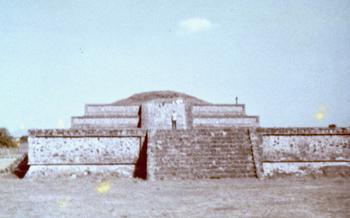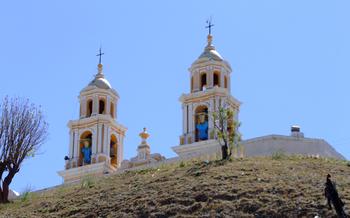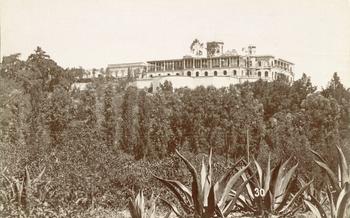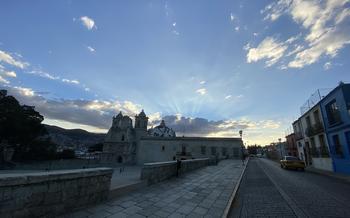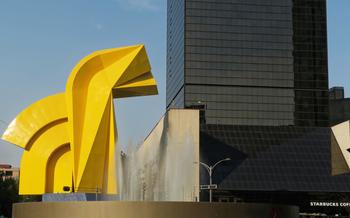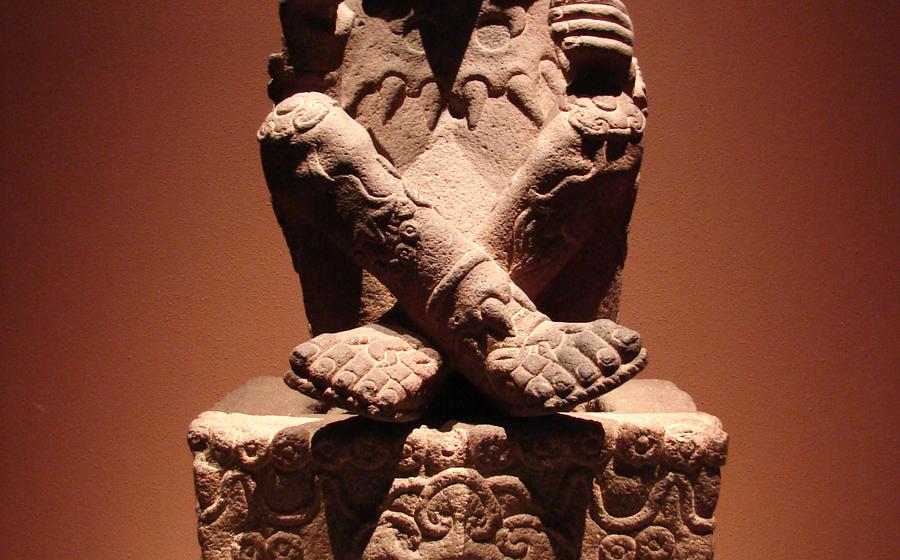
National Museum of Anthropology
- National Museum of Anthropology: A Treasure Trove of Mexican History and Culture
- Navigating the Museum's Vast Collection
- Unraveling the Secrets of the Aztec Civilization
- Discovering the Olmec Civilization's Enigmatic Legacy
- Immerse Yourself in Mayan Culture and History
- Witnessing the Splendor of Teotihuacan's Pyramids
- Unveiling the Zapotec Civilization's Artistic Achievements
- Encountering the Mixtec Codices: Windows into a Complex World
- Exploring the Regional Halls: A Journey Through Diverse Cultures
- Interactive Exhibits: Bringing History to Life
- Temporary Exhibitions: Showcasing Cutting-Edge Research
- Guided Tours: Unveiling Hidden Stories
- Tips for Photography Enthusiasts: Capturing the Museum's Beauty
- Insider Tip: Experience the Museum's Rooftop Garden
National Museum of Anthropology: A Treasure Trove of Mexican History and Culture
Nestled in the heart of Mexico City, the National Museum of Anthropology stands as a testament to the rich tapestry of Mexican history and culture. Founded in 1964, this world-renowned institution houses an unparalleled collection of artifacts, sculptures, and relics that tell the captivating story of Mexico's diverse indigenous civilizations. With over 8 million objects spanning 3,000 years of history, the museum offers an immersive journey through the vibrant cultures that have shaped Mexico's national identity.
The museum's significance lies in its role as a guardian of Mexico's cultural heritage. Its vast collection encompasses masterpieces from ancient civilizations such as the Aztecs, Mayas, Olmecs, Zapotecs, and Mixtecs, providing a comprehensive overview of the country's pre-Columbian past. Through meticulously curated exhibits and galleries, the museum invites visitors to delve into the intricacies of these ancient societies, their sophisticated belief systems, and their enduring impact on contemporary Mexican culture.
Navigating the Museum's Vast Collection
To make the most of your visit to the National Museum of Anthropology, planning is key. Start by obtaining a map of the museum to orient yourself with the various exhibits and galleries. Allocate sufficient time to explore each section, as the museum is vast and rich in content.
Don't miss the museum's unmissable highlights, such as the iconic Aztec Calendar, a symbol of the empire's advanced astronomical knowledge. Marvel at the colossal heads of the Olmec civilization, evoking mystery and intrigue. Take time to explore the regional halls, each dedicated to a specific indigenous culture, showcasing their unique contributions to Mexican heritage.
To delve deeper into the museum's treasures, consider joining a guided tour. Led by knowledgeable guides, these tours offer insightful explanations and anecdotes, bringing the exhibits to life. Alternatively, rent an audio guide for a self-paced tour, allowing you to explore at your own rhythm.
Unraveling the Secrets of the Aztec Civilization
The Aztec Empire, one of Mexico's most influential pre-Columbian civilizations, left an indelible mark on the country's history and culture. The National Museum of Anthropology houses an impressive collection of Aztec artifacts, providing visitors with an in-depth look into this extraordinary civilization.
Explore the Aztec exhibits to discover intricate sculptures, finely crafted pottery, and beautifully preserved codices. Marvel at the colossal stone heads, each representing a different Aztec ruler, and immerse yourself in the grandeur of the Aztec Calendar, a testament to their advanced astronomical knowledge.
Learn about the Aztec way of life, their religious beliefs, and their sophisticated social structure. Discover the significance of human sacrifice in Aztec culture and its role in maintaining the balance between the gods and the mortal world.
Through the museum's exhibits, you'll gain a deeper understanding of the Aztec civilization's rise, its achievements, and its eventual fall. Immerse yourself in the captivating story of this once-mighty empire and unravel the secrets that continue to fascinate scholars and visitors alike.
Discovering the Olmec Civilization's Enigmatic Legacy
The Olmec civilization, which flourished in the Gulf Coast region of Mexico from around 1200 to 400 BC, remains one of the most enigmatic and fascinating ancient societies in Mesoamerica. The National Museum of Anthropology houses a remarkable collection of Olmec artifacts that shed light on this mysterious civilization's origins, culture, and artistic achievements.
Among the highlights of the museum's Olmec collection are the colossal heads, massive stone sculptures that are considered to be some of the most iconic representations of Olmec art. These colossal heads, which can weigh up to 20 tons and stand over 9 feet tall, depict the faces of Olmec rulers or deities with distinctive features such as wide-open eyes, thick lips, and flat noses. Their purpose and significance are still debated among scholars, but they are widely regarded as symbols of Olmec power and authority.
Another notable feature of the Olmec collection is the collection of stone carvings, which include intricate reliefs, stelae, and figurines. These carvings depict a variety of subjects, including Olmec rulers, deities, and mythical creatures. They provide valuable insights into Olmec religious beliefs, social structure, and artistic style.
The museum's Olmec exhibits also present theories and speculations surrounding the origins and demise of the Olmec civilization. While much is still unknown about the Olmecs, the museum's collection offers a glimpse into this enigmatic society and its enduring legacy in Mexican history and culture.
Immerse Yourself in Mayan Culture and History
Journey into the realm of the ancient Maya civilization, one of the most sophisticated and influential cultures in Mesoamerica. The National Museum of Anthropology's Mayan exhibits transport you back in time, revealing the intricacies of their calendar system, their advanced city-states, and their profound understanding of astronomy and mathematics.
Marvel at the intricate carvings adorning Mayan stelae, each telling a unique story of their history and mythology. Discover the secrets of the Mayan script, one of the few fully developed writing systems in pre-Columbian America, and immerse yourself in the vibrant colors and designs of their elaborate ceramics and jade carvings.
Witness the mastery of Mayan artisans as you explore the museum's collection of jade figurines, masks, and jewelry. These exquisite pieces showcase the exceptional craftsmanship and artistic sensibility that characterized Mayan culture. Don't miss the opportunity to delve deeper into the Mayan world through the museum's interactive exhibits, which bring their culture to life through hands-on activities and multimedia presentations.
Witnessing the Splendor of Teotihuacan's Pyramids
Teotihuacan, one of the largest pre-Columbian cities in the Americas, stands as a testament to the ingenuity and architectural prowess of its ancient inhabitants. The National Museum of Anthropology proudly showcases a collection of artifacts and exhibits that transport visitors back in time to this remarkable city.
Among the highlights of the Teotihuacan exhibits are intricate models and sculptures that provide a glimpse into the city's layout and daily life. Gaze upon the meticulously crafted Pyramid of the Sun, the largest structure in Teotihuacan, and marvel at the engineering feats that allowed its construction without the use of modern tools.
The museum also houses an impressive collection of murals and paintings that once adorned the walls of Teotihuacan's temples and palaces. These vibrant artworks depict scenes from mythology, history, and everyday life, offering a rare glimpse into the minds and beliefs of the Teotihuacan people.
The National Museum of Anthropology's Teotihuacan exhibits serve as a gateway to understanding the grandeur and complexity of this ancient city. Whether you're a history buff, an architecture enthusiast, or simply curious about the wonders of the past, these exhibits offer an immersive and awe-inspiring experience.
Unveiling the Zapotec Civilization's Artistic Achievements
The Zapotec civilization, renowned for its sophisticated writing system and artistry, played a significant role in the cultural tapestry of ancient Mexico. The National Museum of Anthropology proudly showcases the Zapotec legacy through an array of captivating exhibits.
One of the highlights of the Zapotec collection is the exquisite gold jewelry, meticulously crafted by skilled Zapotec artisans. These intricate pieces, adorned with intricate designs and precious gemstones, offer a glimpse into the Zapotec's refined sense of aesthetics and craftsmanship.
Equally impressive are the monumental stone carvings, which depict Zapotec gods, rulers, and mythical creatures with remarkable detail and precision. These sculptures, often adorned with elaborate headdresses and intricate glyphs, provide valuable insights into Zapotec religious beliefs and artistic traditions.
The Zapotec capital city, Monte Albán, was a bustling hub of trade and influence in ancient Mesoamerica. The museum's exhibits showcase artifacts from this important city, including finely carved stone lintels, elaborate ceramic vessels, and intricately painted murals. These artifacts provide a glimpse into the vibrant urban life and cultural achievements of the Zapotec civilization.
Through these captivating exhibits, the National Museum of Anthropology invites visitors to explore the rich artistic legacy of the Zapotec people, celebrating their contributions to the cultural heritage of Mexico.
Encountering the Mixtec Codices: Windows into a Complex World
In the heart of the National Museum of Anthropology, visitors can embark on an extraordinary journey through time as they encounter the Mixtec codices, pre-Columbian manuscripts that hold the key to understanding a rich and complex civilization. These painted books, crafted on deerskin or bark paper, offer a glimpse into the intricate world of the Mixtec people, a Mesoamerican culture that flourished in the Oaxaca region of southern Mexico.
With their vibrant colors and intricate symbols, the Mixtec codices narrate historical events, myths, genealogies, and rituals, providing invaluable insights into the social, political, and religious life of this ancient society. Through these beautifully preserved manuscripts, visitors can witness the Mixtecs' sophisticated writing system, which combined logographic and phonetic elements to convey a wealth of information.
One of the most remarkable features of the Mixtec codices is their historical accuracy. They meticulously record genealogies, alliances, and territorial disputes, offering a detailed account of Mixtec history and providing valuable information for scholars studying this fascinating civilization. Additionally, the codices contain rich iconography that depicts Mixtec deities, rituals, and everyday life, offering a glimpse into their beliefs and cultural practices.
Exploring the Mixtec codices at the National Museum of Anthropology is a journey into a world of complexity and beauty. These manuscripts are not merely historical documents but also works of art, showcasing the Mixtecs' exceptional artistic skills and their profound understanding of their world. As visitors delve into the stories and symbols contained within these precious codices, they gain a deeper appreciation for the rich cultural heritage of Mexico and the enduring legacy of the Mixtec civilization.
Exploring the Regional Halls: A Journey Through Diverse Cultures
The National Museum of Anthropology's regional halls offer a captivating glimpse into the rich tapestry of Mexican indigenous cultures. Each hall is dedicated to a specific region, showcasing a diverse array of artifacts, textiles, and cultural expressions.
In the Gulf Coast hall, visitors can admire the intricate gold jewelry and finely carved jade figurines of the ancient Veracruz culture. The Oaxaca hall presents an immersive journey through the history of the Zapotec and Mixtec civilizations, with highlights including the exquisitely painted ceramic urns and the enigmatic Mixtec codices.
The Maya area hall houses an impressive collection of Mayan artifacts, including intricately carved stone stelae, polychrome ceramics, and jade masks. Visitors can learn about the Maya's sophisticated writing system, their advanced mathematical and astronomical knowledge, and their unique artistic traditions.
These regional halls provide a comprehensive overview of the diverse cultures that have shaped Mexico's rich history. By exploring these halls, visitors gain a deeper understanding of the country's vibrant indigenous heritage and the interconnectedness of its diverse communities.
Interactive Exhibits: Bringing History to Life
The National Museum of Anthropology isn't just a repository of ancient artifacts; it's also an interactive playground where visitors of all ages can engage with history in a hands-on way. The museum's innovative exhibits use multimedia displays, virtual reality experiences, and hands-on activities to bring the past to life.
One of the most popular interactive exhibits is the "Journey Through Time" multimedia presentation. This immersive experience takes visitors on a virtual journey through the history of Mexico, from the Olmec civilization to the present day. Visitors can interact with holographic projections, touch screens, and other high-tech displays to learn about the country's rich cultural heritage.
Another highlight is the "Hands-On History" exhibit, where visitors can try their hand at traditional Mexican crafts and activities. Visitors can learn to weave textiles, make pottery, or even play traditional Mexican instruments.
The National Museum of Anthropology's interactive exhibits are a great way to make history come alive for visitors of all ages. Whether you're a history buff, a tech enthusiast, or just looking for a fun and educational experience, you're sure to find something to enjoy at this world-renowned museum.
Temporary Exhibitions: Showcasing Cutting-Edge Research
The National Museum of Anthropology is not just a repository of ancient artifacts but also a hub for cutting-edge research and contemporary artistic expression. Its temporary exhibition program provides a platform for scholars, artists, and curators to explore diverse themes, cultures, and artistic movements.
Past exhibitions have delved into topics such as the history of Mexican photography, the influence of pre-Columbian art on modern design, and the role of women in ancient Mesoamerican societies. These exhibitions often feature new discoveries, thought-provoking interpretations, and innovative display techniques that challenge traditional narratives and shed fresh light on Mexico's rich cultural heritage.
Temporary exhibitions are a great way to experience the museum's collection in a new and dynamic way. They offer visitors the opportunity to engage with contemporary scholarship, discover emerging artists, and gain new perspectives on Mexican history and culture.
Be sure to check the museum's website or inquire at the information desk for details on current and upcoming temporary exhibitions. Don't miss this chance to experience the National Museum of Anthropology as a living, breathing institution that is constantly evolving and expanding its understanding of Mexico's past and present.
Guided Tours: Unveiling Hidden Stories
The National Museum of Anthropology offers guided tours in various languages, led by knowledgeable museum guides who bring the exhibits to life with their in-depth explanations and insights. These tours are an excellent way to delve deeper into the museum's collection and gain a comprehensive understanding of Mexican history and culture.
Benefits of Guided Tours:
- Expert Insights: Guides provide a wealth of information and anecdotes that enrich the visitor experience, offering a deeper understanding of the artifacts and their cultural significance.
- Tailored Experience: Tours can be customized based on specific interests, allowing visitors to focus on particular exhibits or themes that resonate with them.
- Interactive Engagement: Guides encourage questions and discussions, creating an interactive learning environment that fosters a deeper connection with the museum's collection.
Tips for Booking a Guided Tour:
- Advance Booking: Tours are popular, so it's advisable to book in advance to secure a spot, especially during peak tourist seasons.
- Language Preference: Choose a tour in your preferred language to ensure you can fully comprehend the guide's explanations.
- Group Size: Consider the size of the group to ensure a personalized experience. Smaller groups often allow for more in-depth discussions and questions.
Whether you're a history buff, an art enthusiast, or simply curious about Mexican culture, a guided tour of the National Museum of Anthropology is an invaluable experience that will leave you with a profound appreciation for the country's rich heritage.
Tips for Photography Enthusiasts: Capturing the Museum's Beauty
The National Museum of Anthropology is a treasure trove for photography enthusiasts, offering countless opportunities to capture the beauty and grandeur of Mexico's rich cultural heritage. While photography is generally permitted within the museum, it is essential to be respectful of other visitors and museum regulations.
To ensure the best possible experience, here are some tips for photography enthusiasts:
-
Respect the Rules: Familiarize yourself with the museum's photography policy before your visit. Some areas, such as temporary exhibitions or specific artifacts, may have restrictions or require special permission for photography.
-
Choose the Right Equipment: A wide-angle lens is ideal for capturing the vastness of the museum's halls and exhibits. A tripod can help stabilize your camera for sharp shots, especially in low-light conditions.
-
Composition is Key: Take your time to compose your shots carefully. Look for interesting angles, lighting, and juxtapositions that will make your photos stand out.
-
Capture the Details: Don't just focus on the big picture. Zoom in to capture the intricate details of artifacts, sculptures, and murals. These close-ups can reveal hidden stories and textures that might otherwise go unnoticed.
-
Experiment with Lighting: The museum's lighting can vary depending on the time of day and the exhibit. Experiment with different settings and angles to create dramatic effects and highlight specific features of the exhibits.
-
Use Natural Light: Whenever possible, take advantage of natural light streaming through the museum's windows. Natural light can add warmth and depth to your photos, creating a more authentic feel.
-
Be Patient: Photography in a museum requires patience. Wait for the right moment, when the crowds clear or the light is just right, to capture the perfect shot.
Insider Tip: Experience the Museum's Rooftop Garden
Amidst the bustling energy of Mexico City, the National Museum of Anthropology offers a hidden sanctuary—its rooftop garden. As you ascend to the terrace, a tranquil oasis unfolds before your eyes. Lush greenery, vibrant flowers, and towering trees create a serene atmosphere, a stark contrast to the urban landscape below.
Take a moment to soak in the breathtaking views that stretch beyond the museum's walls. The sprawling expanse of Chapultepec Park unfurls before you, its verdant greenery dotted with majestic trees and tranquil lakes. The cityscape rises in the distance, a harmonious blend of colonial architecture and modern skyscrapers.
This hidden gem is the perfect spot to take a break from exploring the museum's vast collection. Find a secluded bench beneath the shade of a tree and let the tranquility of the garden wash over you. Listen to the gentle rustling of leaves, the chirping of birds, and the distant hum of the city, creating a symphony of sounds that soothe the soul.
The rooftop garden is particularly magical during sunset. As the golden rays bathe the city in a warm glow, the garden transforms into a canvas of vibrant hues. The sky erupts in a kaleidoscope of colors, casting an ethereal glow on the surrounding landscape. It's a moment to pause, reflect, and appreciate the beauty that surrounds us.
Whether you're seeking a moment of respite, inspiration, or simply a different perspective on Mexico City, the rooftop garden of the National Museum of Anthropology is a must-visit. It's a reminder that even amidst the bustling energy of a metropolis, there are hidden pockets of serenity and beauty waiting to be discovered.



